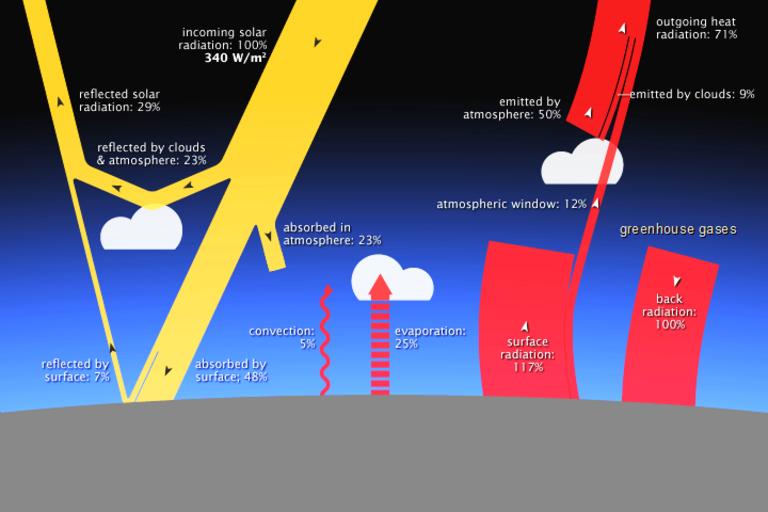MAKE A MEME
View Large Image

| View Original: | Diagram showing the Earth's energy budget, which includes the greenhouse effect (NASA).png (720x480) | |||
| Download: | Original | Medium | Small | Thumb |
| Courtesy of: | commons.wikimedia.org | More Like This | ||
| Keywords: Diagram showing the Earth's energy budget, which includes the greenhouse effect (NASA).png is an edited quote from a public-domain source Lindsey 2009 On average 340 watts per square meter W m<sup>-2</sup> of solar energy arrives at the top of the atmosphere Earth returns an equal amount of energy back to space by reflecting some incoming light and by radiating heat thermal infrared energy Most solar energy is absorbed at the surface while most heat is radiated back to space by the atmosphere Earth's average surface temperature is maintained by two large opposing energy fluxes between the atmosphere and the ground right ”the greenhouse effect <br/><br/>Incoming solar radiation to the Earth is equal to 340 watts per square meter 100 Of this units are a percentage of incoming solar radiation to the Earth 29 is reflected back into space This is reflected by clouds and the atmosphere 23 and the Earth's surface 7 23 is absorbed in the atmosphere 48 is absorbed by the Earth's surface The Earth's surface releases 5 of the energy into the atmosphere by convection and 25 by evaporation <br/><br/>The amount of heat radiated from the atmosphere to the surface sometimes called back radiation is equivalent to 100 percent of the incoming solar energy The Earth ™s surface responds to the extra on top of direct solar heating energy by raising its temperature The amount of heat a surface radiates is proportional to the fourth power of its temperature the Stefan-Boltzmann law As solar heating and back radiation from the atmosphere raise the surface temperature the surface simultaneously releases an increasing amount of heat ”equivalent to about 117 percent of incoming solar energy The net upward heat flow from the Earth's surface is equivalent to 17 percent of incoming sunlight 117 percent up minus 100 percent down <br/><br/>Some of the heat escapes directly to space and the rest is transferred to higher and higher levels of the atmosphere until the energy leaving the top of the atmosphere matches the amount of incoming solar energy Because the maximum possible amount of incoming sunlight is fixed by the solar constant which depends only on Earth ™s distance from the Sun and very small variations during the solar cycle the natural greenhouse effect does not cause a runaway increase in surface temperature on Earth <br/><br/>In the diagram as before energy flows are measured as a proportion of incoming solar radiation to the Earth heat directly leaving the Earth's surface through the atmospheric window equals 12 50 of heat is emitted by the atmosphere Of this 9 is emitted by clouds total outgoing heat radiation equals 71 Trenberth et al 2009 estimate an energy imbalance at the top-of-the-atmosphere of 0 9 watts per square meter due to the enhanced greenhouse effect <br/><br/>The diagram was adapted by Robert Simmon from Trenberth et al 2009 using CERES flux estimates provided by Norman Loeb <br/><br/>References Lindsey R January 14 2009 http //earthobservatory nasa gov/Features/EnergyBalance/page4 php Earth ™s Energy Budget page 4 and http //earthobservatory nasa gov/Features/EnergyBalance/page6 php The Atmosphere ™s Energy Budget page 6 in http //earthobservatory nasa gov/Features/EnergyBalance/page1 php Climate and Earth ™s Energy Budget Feature Articles Publisher http //earthobservatory nasa gov/index php Earth Observatory part of the EOS Project Science Office located at NASA Goddard Space Flight Center Trenberth K Fasullo J Kiehl J 2009 http //www cgd ucar edu/cas/Trenberth/trenberth papers/10 1175_2008BAMS2634 1 pdf Earth ™s global energy budget draft copy Bulletin of the American Meteorological Society doi http //dx doi org/10 1175/2008BAMS2634 1 10 1175/2008BAMS2634 1 http //earthobservatory nasa gov/Features/EnergyBalance/images/global_energy_budget_components png global_energy_budget_components png on http //earthobservatory nasa gov/Features/EnergyBalance/page6 php The Atmosphere ™s Energy Budget page 6 in http //earthobservatory nasa gov/Features/EnergyBalance/page1 php Climate and Earth ™s Energy Budget author Lindsey R Feature Articles Publisher http //earthobservatory nasa gov/index php Earth Observatory part of the EOS Project Science Office located at NASA Goddard Space Flight Center Robert Simmon 2009-01-14 http //earthobservatory nasa gov/ImageUse/ Image Use Policy Most materials published on the Earth Observatory including images are freely available for re-publication or re-use including commercial purposes with the following exceptions where copyright is indicated you must obtain the copyright holder ™s permission; we usually provide links to the organization that holds the copyright images from the SeaWiFS sensor older than five years are in the public domain and can be re-used or re-published for any purpose Images less than five years old can be re-used only for educational or scientific purposes; any commercial use of such images must be coordinated with GeoEye We ask that NASA ™s Earth Observatory be given credit for its original materials; the only mandatory credit is NASA Non-copyright status of image confirmed by e-mail Retouched picture 1 Adjusted colors to increase contrast and saturation 2 modified text greenhouse gases to increase contrast Global warming Greenhouse effect Sankey diagrams Energy flow diagrams Enescot | ||||